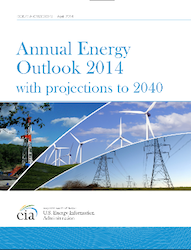According to the SUN DAY Campaign, the U.S. Energy Information Administration’s (EIA) official launch of the complete Annual Energy Outlook – 2014 doesn’t pass the laugh test. In follow-up remarks to the preview report launched a few weeks ago, EIA’s projections for renewable electricity generation are way under the mark.
For example, the AEO2014 “Reference case,” EIA notes: “Renewable electricity generation in the United States is projected to grow by 69% from 2012 to 2040…, including an increase of  more than 140% in generation from nonhydropower renewable energy sources. … Although nonhydropower renewable generation more than doubles between 2012 and 2040…, [renewable energy’s] contribution to U.S. total electricity generation is still just 16%.”
more than 140% in generation from nonhydropower renewable energy sources. … Although nonhydropower renewable generation more than doubles between 2012 and 2040…, [renewable energy’s] contribution to U.S. total electricity generation is still just 16%.”
Two other scenarios offered by EIA – the Low Economic Growth and the High Oil and Gas Resource cases – suggest even lower penetration rates by renewables, cites the SUN DAY Campaign. EIA also offers several other scenarios – including the No Sunset and CHG25 cases – in which “renewables account for 24% and 27%, respectively, of total electricity generation in 2040. … In fact, renewable penetration of electricity supply in both cases meets or surpasses 16% by 2020, which is the level attained in the Reference case by 2040.”
Significantly, says the SUN DAY Campaign, these latter projections are higher than those presented in the past by EIA. However, while more credible, these scenarios will also almost certainly prove to be unduly conservative. In fact, the association cites, based on the actual growth rates for renewable energy sources (i.e., biomass, geothermal, hydropower, solar, wind) over the past decade, multiple other studies, and even analyses from EIA itself, it is likely that renewables will comprise a much larger share of the nation’s electrical generating supply by 2040 — perhaps two, three or more times higher than the Reference case level forecast by EIA.
In conclusion, SUN DAY Campaign says there are multiple grounds for challenging EIA forecasts.

